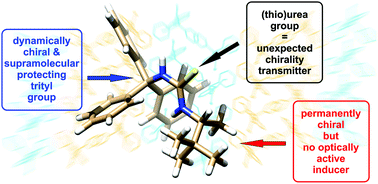Dynamic optical activity induction in the N-alkyl-N′-trityl ureas and thioureas†
Abstract
Considered to be rigid, the urea and thiourea functionalities, often used in material chemistry and in asymmetric organocatalysis, are able to transmit information regarding 3D structure from a permanently chiral inducer part to a dynamically chiral (reporter) part of the molecule. Despite a considerable distance between the inducer and the reporter parts of the molecule, the chirality transfer phenomenon has been demonstrated for a series of secondary N-alkyl-N′-trityl ureas and thioureas. The induction of helicity in a stereodynamic trityl propeller is revealed by rising non-zero Cotton effects in the area of trityl absorption. The information regarding the 3D structure of the inducer is transferred to the reporter part of the system through a set of weak but complementary electrostatic interactions. The presence of two supramolecular motifs in the same molecule, characterized by opposite properties, significantly affected the molecular solid state structure of the thioureas and their abilities to assemble. In the crystalline phase, the model, a chiral N-tert-butyl-thiourea derivative that retains the extended Z,Z conformation of the linker, is prone to form a supramolecular network typical of secondary ureas and thioureas. In contrast, the presence of the hydrophobic trityl group suppresses the thioamide NH⋯S![[double bond, length as m-dash]](https://www.rsc.org/images/entities/char_e001.gif) C hydrogen bonds. Therefore, trityl acts as a supramolecular protecting group for thioamide functionality, hampering the formation of hydrogen bonded networks in the solid state.
C hydrogen bonds. Therefore, trityl acts as a supramolecular protecting group for thioamide functionality, hampering the formation of hydrogen bonded networks in the solid state.

- This article is part of the themed collections: Supramolecular chemistry in OBC and Mechanistic, computational & physical organic chemistry in OBC


 Please wait while we load your content...
Please wait while we load your content...